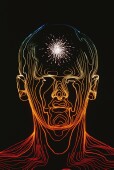Therapy reduces pain level by about one-third for up to a month
MONDAY, March 2, 2015 (HealthDay News) — A procedure that delivers lidocaine directly to nerves in the back of the nasal cavity appears to offer significant relief to migraine sufferers, preliminary research indicates. The findings were scheduled to be presented at the annual meeting of the Society of Interventional Radiology, held from Feb. 28 to March 5 in Atlanta.
Kenneth Mandato, M.D., a vascular and interventional radiologist at the Albany Medical Center in New York, and colleagues focused on 112 patients averaging about 45 years of age. All had been diagnosed with either migraines or cluster headaches. Before participating in the study, patients were asked to indicate their pain levels according to a standardized scale from 1 to 10. Pre-treatment pain scores averaged more than 8, Mandato told HealthDay. The participants all underwent a session of “image-guided therapy,” in which a catheter was inserted through a nostril and into the nasal passage to deliver a dose of lidocaine to the sphenopalatine ganglion. This was then repeated in the opposite nostril. Mandato stressed that no one in the study required sedation to undergo the procedure.
The day after the procedure, average migraine pain levels had dropped from about 8 to just over 4. Pain scores rose only marginally a week after the procedure, and reached an average of just over 5 by the one month post-procedure mark. The procedure didn’t help everyone, though. Seven of the patients (about 6 percent) failed to get any benefit from the treatment, the investigators found. However, 88 percent of those in the study reported needing less standard pain relief medication after the procedure.
The researchers acknowledged that this procedure is a temporary solution that would need to be repeated. Mandato said his team is continuing to monitor patients to see how well the nasal spray approach holds up six months out.
Copyright © 2015 HealthDay. All rights reserved.








